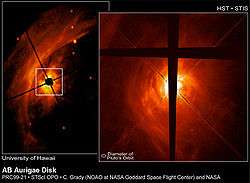AB Aurigae
 AB Aurigae and its dust disk. | |
| Observation data Epoch J2000 Equinox J2000 | |
|---|---|
| Constellation | Auriga |
| Right ascension | 04h 55m 45.8445s |
| Declination | +30° 33′ 04.292″ |
| Apparent magnitude (V) | 7.05[1] |
| Characteristics | |
| Spectral type | A0Vpe |
| U−B color index | +0.04[2] |
| B−V color index | +0.11[2] |
| Variable type | Orion |
| Astrometry | |
| Radial velocity (Rv) | 8.90 ± 0.9[3] km/s |
| Proper motion (μ) | RA: 2.63[4] mas/yr Dec.: -24.73[4] mas/yr |
| Parallax (π) | 7.18 ± 0.96[4] mas |
| Distance | approx. 450 ly (approx. 140 pc) |
| Details | |
| Mass | 2.4[5] M☉ |
| Radius | 2.5[6] R☉ |
| Luminosity | 47[5] L☉ |
| Temperature | 9772[5] K |
| Other designations | |
| Database references | |
| SIMBAD | data |
AB Aurigae is a star in the Auriga constellation. It is known for hosting a dust disk that may harbour a condensing planet or brown dwarf. The star could host a possible substellar companion in wide orbit.
Planetary system
Oppenheimer et al. (2008)[7] observed an annulus feature in AB Aurigae's dust disk between 43 and 302 AU from the star, a region never seen before. An azimuthal gap in an annulus of dust at a radius of 102 AU would suggest the formation of at least one small body at an orbital distance of nearly 100 AU. Such object could turn out either a massive planetary companion or more likely a brown dwarf companion, in both cases located at nearly 100 AU from the bright star. So far the object is unconfirmed.
| Companion (in order from star) |
Mass | Semimajor axis (AU) |
Orbital period (years) |
Eccentricity | Inclination | Radius |
|---|---|---|---|---|---|---|
| b (unconfirmed) | ≥5–37 MJ | 102 | ≥800 | ? | — | — |
References
- ↑ Ducati, J. R. (2002). "VizieR Online Data Catalog: Catalogue of Stellar Photometry in Johnson's 11-color system". CDS/ADC Collection of Electronic Catalogues. 2237. Bibcode:2002yCat.2237....0D.
- 1 2 Nicolet, B. (1964). "Catalogue of homogeneous data in the UBV photoelectric photometric system". Astronomy and Astrophysics Supplement Series. 34: 1–49. Bibcode:1978A&AS...34....1N.
- ↑ Gontcharov, G. A. (2006). "Pulkovo Compilation of Radial Velocities for 35 495 Hipparcos stars in a common system". Astronomy Letters. 32 (11): 759–771. arXiv:1606.08053. Bibcode:2006AstL...32..759G. doi:10.1134/S1063773706110065.
- 1 2 3 van Leeuwen, F.; et al. (2007). "Validation of the new Hipparcos reduction". Astronomy and Astrophysics. 474 (2): 653–664. arXiv:0708.1752. Bibcode:2007A&A...474..653V. doi:10.1051/0004-6361:20078357.
- 1 2 3 Tannirkulam, A.; Monnier, J. D.; Harries, T. J.; Millan‐Gabet, R.; Zhu, Z.; Pedretti, E.; Ireland, M.; Tuthill, P.; Ten Brummelaar, T.; McAlister, H.; Farrington, C.; Goldfinger, P. J.; Sturmann, J.; Sturmann, L.; Turner, N. (2008). "A Tale of Two Herbig Ae Stars, MWC 275 and AB Aurigae: Comprehensive Models for Spectral Energy Distribution and Interferometry". The Astrophysical Journal. 689: 513–531. arXiv:0808.1728. Bibcode:2008ApJ...689..513T. doi:10.1086/592346.
- ↑ Li, Dan; Pantin, Eric; Telesco, Charles M.; Zhang, Han; Wright, Christopher M.; Barnes, Peter J.; Packham, Chris; Mariñas, Naibí (2016). "AN ORDERED MAGNETIC FIELD IN THE PROTOPLANETARY DISK OF AB Aur REVEALED BY MID-INFRARED POLARIMETRY". The Astrophysical Journal. 832: 18. arXiv:1609.02493. Bibcode:2016ApJ...832...18L. doi:10.3847/0004-637X/832/1/18.
- 1 2 Oppenheimer, Ben R.; et al. (2008). "The Solar-System-Scale Disk around AB Aurigae". The Astrophysical Journal. 679 (2): 1574–1581. arXiv:0803.3629. Bibcode:2008ApJ...679.1574O. doi:10.1086/587778.
Further reading
- Telleschi, A.; Güdel, M.; Briggs, K. R.; Skinner, S. L.; Audard, M.; Franciosini, E. (2007). "The first high-resolution X-ray spectrum of a Herbig star: AB Aurigae". The Astrophysical Journal. 468 (2): 541–556. arXiv:astro-ph/0610456. Bibcode:2007A&A...468..541T. doi:10.1051/0004-6361:20065422.
- Oppenheimer, Ben R.; Brenner, Douglas; Hinkley, Sasha; Zimmerman, Neil; Sivaramakrishnan, Anand; Soummer, Remi; et al. (2008). "The Solar-System-Scale Disk around AB Aurigae". The Astrophysical Journal. 679 (2): 1574–1581. arXiv:0803.3629. Bibcode:2008ApJ...679.1574O. doi:10.1086/587778.
- Bitner, Martin A.; Richter, Matthew J.; Lacy, John H.; Greathouse, Thomas K.; Jaffe, Daniel T.; Blake, Geoffrey A. (2007). "TEXES Observations of Pure Rotational H2 Emission from AB Aurigae". The Astrophysical Journal. 661 (1): L69–L72. arXiv:0704.1481. Bibcode:2007ApJ...661L..69B. doi:10.1086/518717.
- Fukagawa, Misato; Hayashi, Masahiko; Tamura, Motohide; Itoh, Yoichi; Hayashi, Saeko S.; Oasa, Yumiko; et al. (2004). "Spiral Structure in the Circumstellar Disk around AB Aurigae". The Astrophysical Journal. 605 (1): L53–L56. Bibcode:2004ApJ...605L..53F. doi:10.1086/420699.
- L. P. Keller; S. Hony; J. P. Bradley; F. J. Molster; L. B. F. M. Waters; J. Bouwman; et al. (2002). "Identification of iron sulphide grains in protoplanetary disks". Nature. 417 (6885): 148–150. Bibcode:2002Natur.417..148K. doi:10.1038/417148a. PMID 12000914.
- Overbye, Dennis (2008-03-26). "Star's Dust May Hold Clue to New Planet". www.nytimes.com. Archived from the original on December 10, 2008. Retrieved 2008-08-20.
- "Image AB Aurigae". SIMBAD. Retrieved 2008-08-20.
- "AB Aurigae: How To Make Planets". NASA. Archived from the original on 29 September 2008. Retrieved 2008-08-20.
- "AB Aurigae". jumk.de. Retrieved 2008-10-15.
- "Planet in Progress? Evidence Of A Huge Planet Forming In Star System". Science News. Archived from the original on 10 October 2008. Retrieved 2008-10-15.
- "Spiral Dance in a Planetary Nursery". Subaru Telescope. Retrieved 2008-10-15.
- "The Source of Stelar Magnetism". news.softpedia.com. Retrieved 2008-10-16.
- "XMM-Newton unlocks magnetic mystery". iTWire. Retrieved 2008-10-16.
- "Silicate Stardust in Meteorites". Planetary science research. Retrieved 2008-10-16.
- "Image Multimidea Gallary ESA". ESA. Retrieved 2008-10-16.
External links
This article is issued from
Wikipedia.
The text is licensed under Creative Commons - Attribution - Sharealike.
Additional terms may apply for the media files.